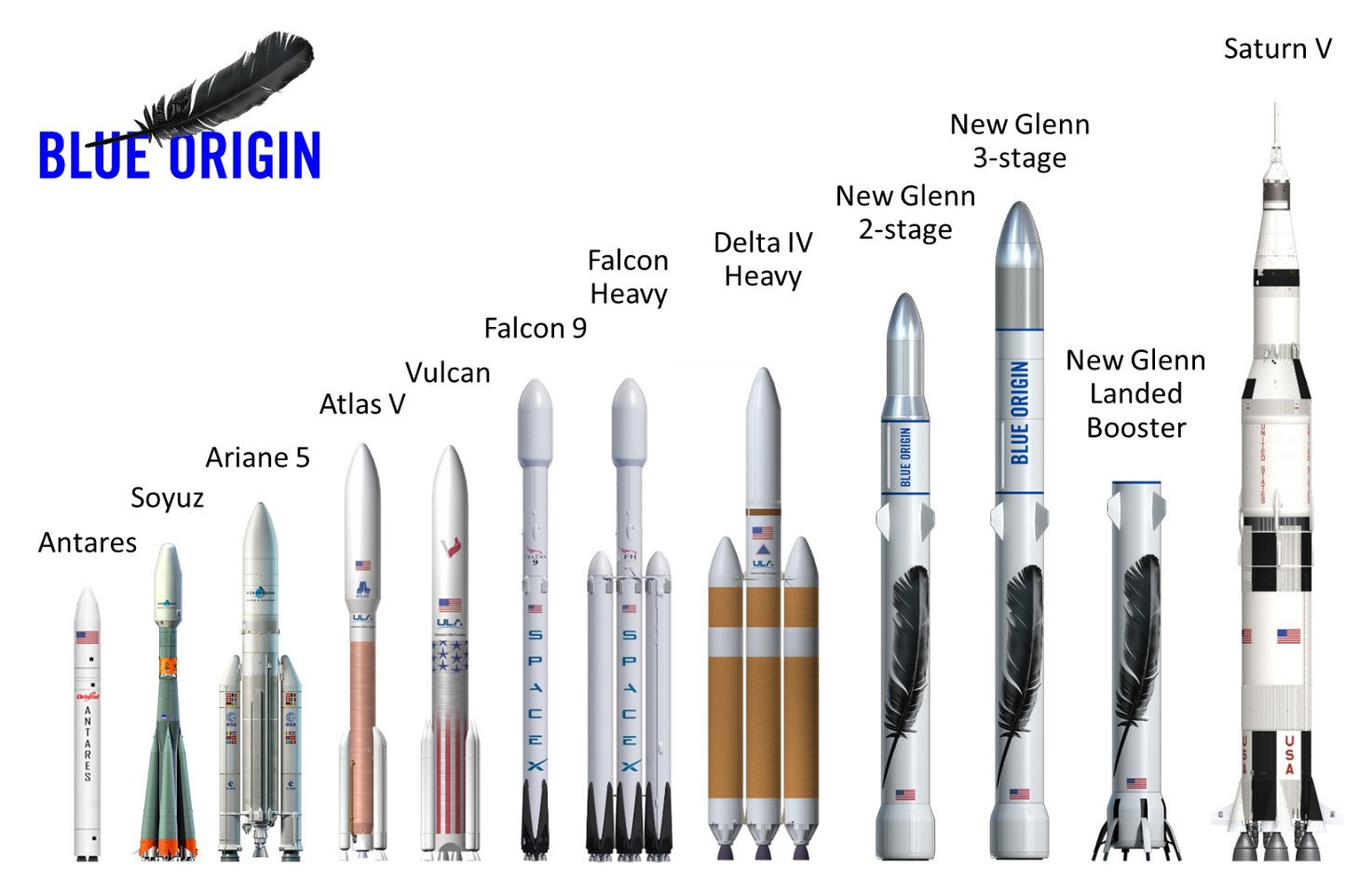Nachdem die Katze nun endlich aus dem Sack ist, und wir hoffentlich demnächst noch viel von Blue Origin und dieser Trägerfamilie hören, habe ich mir gedacht, dass man ihr mal einen eigenen Thread spendieren könnte. Entgegen aller Spekulationen der Internetgemeinde fällt
New Glenn deutlich größer aus als die ursprünglichen Vermutungen im Delta II Bereich beziehungsweise auf jeden Fall nutzlastschwächer als ULAs Vulcan.
New Glenn wird es als zweistufige und dreistufige Variante geben, die ich im weiteren als New Glenn 2 und New Glenn 3 bezeichnen werde.

Technische Daten:
- Stufendurchmesser: 7 Meter
- Höhe New Glenn 2: 82,3 Meter
- Höhe New Glenn 2: 95,4 Meter
- Startschub: 17125 kN
- Triebwerke Erststufe: 7x BE-4
- Triebwerk Zweitstufe: 1x BE-4 Vac.
- Treibstoff/Oxidator BE-4: Methan/LOX
- Triebwerk Drittstufe: 1x BE-3 Vac.
- Treibstoff/Oxidator BE-3: LH2/LOX
- Anzahl Landebeine: 6(?)
- Startkomplex: LC-36 am KSC
- Erststart: Vor 2020
New Glenn 2 ist für unbemannte und bemannte Missionen in den LEO und GTO vorgesehen, New Glenn 3 für BEO-Missionen. Detailierte Angaben zur Nutzlast gibt es bisher nicht, ich nehme an dass findige Forennutzer oder reddit Mitglieder allerdings bald eine erste grobe Abschätzung durchführen werden.
Die erwartete Leistung des BE-4 ist wohl von den bisherigen 2400 kN auf etwa 2450 kN angestiegen. Die Produktion der Rakete und einzelne Triebwerkstest finden direkt am Startgelände statt, Hotfire-Tests des gesamten, integrierten Boosters sind nicht geplant. Die Erststufe wird auf einer Seeplattform, etwa 750 nautische Meilen entfernt vor der Küste South Carolinas startfinden.
Anscheinend arbeitet man gerade auch schon an einem weiteren System namens New Armstrong. Ich bin ja mal gespannt, ob man den beabsichtigten Erststarttermin halten kann, und wie man das Produkt preislich auf dem Markt platziert. Für mich persönlich aber auf jeden Fall eine sehr schöne Entwicklung, dass Blue nun endlich tatsächlich in absehbarer Zeit höchstwahrscheinlich in direkte Konkurrenz zu SpaceX tritt.
Our mascot is the tortoise. We paint one on our vehicles after each successful flight. Our motto is “Gradatim Ferociter” – step by step, ferociously. We believe “slow is smooth and smooth is fast.” In the long run, deliberate and methodical wins the day, and you do things quickest by never skipping steps. This step-by-step approach is a powerful enabler of boldness and a critical ingredient in achieving the audacious. We’re excited to give you a preview of our next step. One we’ve been working on for four years. Meet New Glenn:
Introducing New Glenn: Reusable, vertical-landing booster, 3.85 million pounds thrust Building, flying, landing, and re-flying New Shepard has taught us so much about how to design for practical, operable reusability. And New Glenn incorporates all of those learnings. Named in honor of John Glenn, the first American to orbit Earth, New Glenn is 23 feet in diameter and lifts off with 3.85 million pounds of thrust from seven BE-4 engines. Burning liquefied natural gas and liquid oxygen, these are the same BE-4 engines that will power United Launch Alliance’s new Vulcan rocket.
The 2-stage New Glenn is 270 feet tall, and its second stage is powered by a single vacuum-optimized BE-4 engine. The 3-stage New Glenn is 313 feet tall. A single vacuum-optimized BE-3 engine, burning liquid hydrogen and liquid oxygen, powers its third stage. The booster and the second stage are identical in both variants.
We plan to fly New Glenn for the first time before the end of this decade from historic Launch Complex 36 at Cape Canaveral, Florida. New Glenn is designed to launch commercial satellites and to fly humans into space. The 3-stage variant – with its high specific impulse hydrogen upper stage – is capable of flying demanding beyond-LEO missions. Our vision is millions of people living and working in space, and New Glenn is a very important step. It won’t be the last of course. Up next on our drawing board: New Armstrong. But that’s a story for the future.
Gradatim Ferociter! Jeff Bezos
Anbei noch ein Plan des integrierten Produktions-, Test- und Startkomplex LC-36. Alles unter einem Hut:

Quellen:
[1]:
http://spacenews.com/blue-origin-to-follow-suborbital-new-shepard-with-orbital-new-glenn/[2]:
https://permitting.sjrwmd.com/epermitting/jsp/Search.do?theAction=searchDetail&permitNumber=147362
